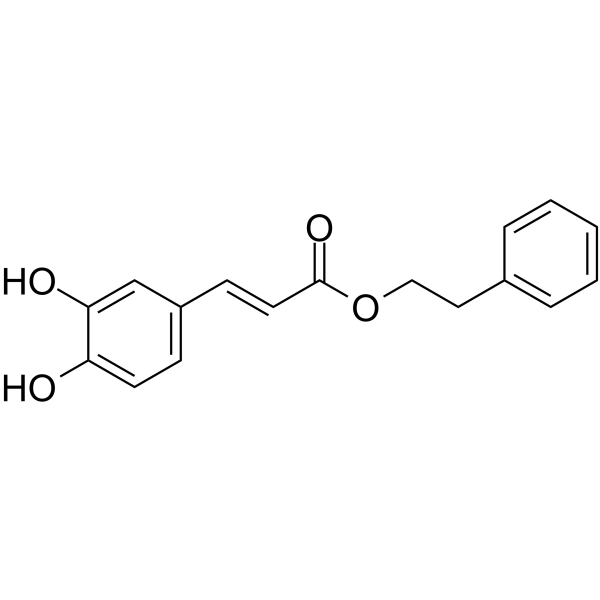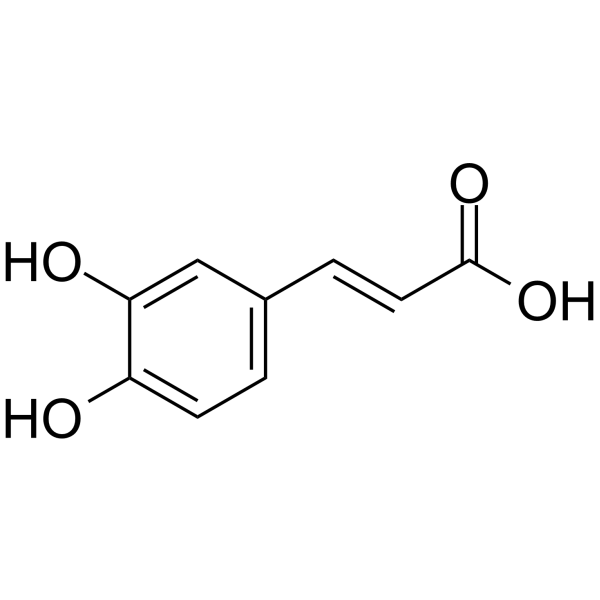上海金畔生物科技有限公司为生命科学和医药研发人员提供生物活性分子抑制剂、激动剂、特异性抑制剂、化合物库、重组蛋白,专注于信号通路和疾病研究领域。
Caffeic acid phenethyl ester (Synonyms: 咖啡酸苯乙酯) 纯度: 98.19%
Caffeic acid phenethyl ester 是一种 NF-κB 抑制剂。

Caffeic acid phenethyl ester Chemical Structure
CAS No. : 104594-70-9
| 规格 | 价格 | 是否有货 | 数量 |
|---|---|---|---|
| Free Sample (0.1-0.5 mg) | Apply now | ||
| 10 mM * 1 mL in DMSO | ¥500 | In-stock | |
| 5 mg | ¥450 | In-stock | |
| 10 mg | ¥600 | In-stock | |
| 100 mg | ¥990 | In-stock | |
| 200 mg | 询价 | ||
| 500 mg | 询价 |
* Please select Quantity before adding items.
Caffeic acid phenethyl ester 相关产品
•相关化合物库:
- Natural Product Library Plus
- Bioactive Compound Library Plus
- Apoptosis Compound Library
- Immunology/Inflammation Compound Library
- NF-κB Signaling Compound Library
- Stem Cell Signaling Compound Library
- Natural Product Library
- Anti-Cancer Compound Library
- Anti-Aging Compound Library
- Antioxidants Compound Library
- Differentiation Inducing Compound Library
- Oxygen Sensing Compound Library
- Medicine Food Homology Compound Library
- Phenols Library
- Pyroptosis Compound Library
- Traditional Chinese Medicine Monomer Library
- Anti-Breast Cancer Compound Library
- Anti-Pancreatic Cancer Compound Library
- Anti-Blood Cancer Compound Library
- Anti-Obesity Compound Library
- Transcription Factor Targeted Library
- Food-Sourced Compound Library
- Anti-Liver Cancer Compound Library
- Rare Diseases Drug Library
| 生物活性 |
Caffeic acid phenethyl ester is a NF-κB inhibitor. |
||||||||||||||||
|---|---|---|---|---|---|---|---|---|---|---|---|---|---|---|---|---|---|
| IC50 & Target[1] |
|
||||||||||||||||
| 体外研究 (In Vitro) |
Caffeic acid phenethyl ester is a NF-κB inhibitor. Cell survival and proliferation of CRPC cell lines are all significantly suppressed by Caffeic acid phenethyl ester (CAPE) treatment dose-dependently. The growth inhibitory effect of Caffeic acid phenethyl ester is evident within 24 hours of treatment but the suppressive effect accumulates over time. The IC50 of 24, 48, 72, and 96 h Caffeic acid phenethyl ester treatment on LNCaP 104-R1 cells is 64.0, 30.5, 20.5, and 18.0 μM, respectively. Colony formation assay reveals that treatment with 10 μM Caffeic acid phenethyl ester reduces colony formation of LNCaP 104-R1 cells by 90% while treatment with 20 μM Caffeic acid phenethyl ester completely blocks the formation of LNCaP 104-R1 colonies. Flow cytometric analysis reveals a reduction of cells in the S phase and G2/M phase but an increase of cells in the G1 phase population in LNCaP 104-R1 cells under Caffeic acid phenethyl ester treatment. Caffeic acid phenethyl ester treatment also significantly decreases protein levels of fatty acid synthase (FAS), retinoblastoma protein (Rb), phospho-Rb Ser807/811, c-Myc, p70S6kinase, phospho-p70S6kinase Thr421/Ser424, Skp2, p90RSK, and NF-κB p65[1]. 上海金畔生物科技有限公司 has not independently confirmed the accuracy of these methods. They are for reference only. |
||||||||||||||||
| 体内研究 (In Vivo) |
Administration of Caffeic acid phenethyl ester (CAPE) by gavage (10 mg/kg body weight per day) for eight weeks results in 50% reduction of tumor volume, suggesting that Caffeic acid phenethyl ester treatment retards the growth of LNCaP 104-R1 xenografts. Caffeic acid phenethyl ester gavage slows down the tumor growth of LNCaP 104-R1 cells, which is consistent with our observation that Caffeic acid phenethyl ester treatment induces cell cycle arrest but not apoptosis[1]. 上海金畔生物科技有限公司 has not independently confirmed the accuracy of these methods. They are for reference only. |
||||||||||||||||
| 分子量 |
284.31 |
||||||||||||||||
| Formula |
C17H16O4 |
||||||||||||||||
| CAS 号 |
104594-70-9 |
||||||||||||||||
| 中文名称 |
咖啡酸苯乙酯 |
||||||||||||||||
| 运输条件 |
Room temperature in continental US; may vary elsewhere. |
||||||||||||||||
| 储存方式 |
|
||||||||||||||||
| 溶解性数据 |
In Vitro:
DMSO : 100 mg/mL (351.73 mM; Need ultrasonic) H2O : 1 mg/mL (3.52 mM; ultrasonic and warming and heat to 80°C) 配制储备液
*
请根据产品在不同溶剂中的溶解度选择合适的溶剂配制储备液;一旦配成溶液,请分装保存,避免反复冻融造成的产品失效。 In Vivo:
请根据您的实验动物和给药方式选择适当的溶解方案。以下溶解方案都请先按照 In Vitro 方式配制澄清的储备液,再依次添加助溶剂: ——为保证实验结果的可靠性,澄清的储备液可以根据储存条件,适当保存;体内实验的工作液,建议您现用现配,当天使用; 以下溶剂前显示的百
|
||||||||||||||||
| 参考文献 |
|
| Kinase Assay [1] |
LNCaP 104-R1 cells are treated with 0, 10, 20, or 40 μM Caffeic acid phenethyl ester (CAPE) for 96 h. Three biological replicates of cells are lysed in SDS lysis buffer (240 mM Tris-acetate, 1% SDS, 1% glycerol, 5 mM EDTA pH 8.0) with DTT, protease inhibitors, and a cocktail of phosphatase inhibitors. Micro-Western Arrays are performed to measure protein expression and phosphorylation status modification[1]. 上海金畔生物科技有限公司 has not independently confirmed the accuracy of these methods. They are for reference only. |
|---|---|
| Cell Assay [1] |
LNCaP 104-R1 cells are seeded at a density of 3×103 cells per well in a 96-well plate. After 24 h, the cells are treated with increasing concentrations of Caffeic acid phenethyl ester (CAPE) for 96 h. Cell viability is assessed by an MTT (3,4,5-dimethylthiazol-2-yl)-2–5-diphenyltetrazolium bromide) assay. The amount of formazan is determined by measuring the absorbance at 560 nm using a plate reader. All results are normalized to the average of the control condition in each individual experiment. All experiments are repeated three times. Each time ten wells are utilized for each condition. The mean and standard deviation represent the results from all 30 wells in the three experiments[1]. 上海金畔生物科技有限公司 has not independently confirmed the accuracy of these methods. They are for reference only. |
| Animal Administration [1] |
Male Balb/c nu/nu mice at age 6 to 8 weeks of age are injected subcutaneously in both flanks with 5×105 LNCaP 104-R1 cells suspended in 0.5 mL of Matrigel and are injected subcutaneously into athymic mice to form tumors. After 14 weeks, the average tumor volume exceeds 150 mm3. The mice are then separated into control group and Caffeic acid phenethyl ester (CAPE) treatment group. Control group contains 6 mice and 8 tumors, while Caffeic acid phenethyl ester treatment group contains 6 mice and 9 tumors. Caffeic acid phenethyl ester (10 mg/kg/day in sesame oil) or vehicle (sesame oil) is administered by gavage starting from 14th week after cancer cell injection. Tumor volume and body weight of mice carrying 104-R1 xenografts are measured weekly using calipers and volume is calculated using the formula volume=length×width×height×0.52[1]. 上海金畔生物科技有限公司 has not independently confirmed the accuracy of these methods. They are for reference only. |
| 参考文献 |
|
所有产品仅用作科学研究或药证申报,我们不为任何个人用途提供产品和服务

